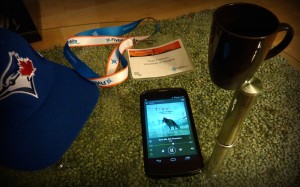
Today was the first day of the papers program at Mobile HCI ’14 and amongst the great talks was one I particularly liked on the idea of “around-device devices” by Pohl et al. [link]. I’ve written before about around-device interaction, above-device interaction, and how the space around mobile devices can be used for gesturing. What’s novel about interaction using around-device devices, however, is that interaction in the around-device space is not just limited to free-hand gestures relative to the device. Instead, nearby objects can become potential inputs in the user interface. One of the motivations for using nearby objects for interaction is that mobile devices are very commonly kept on surfaces – tables, desks, kitchen worktops – which are also used for storing objects. In this post title I call these ordinary surfaces to distance this idea from interactive surfaces.
The example Henning Pohl gives in the paper title is “my coffee mug is a volume dial“. I think this example captures the idea of around-device devices well: mugs, being cylindrical objects, afford certain interactions. In this case, turning them around. There’s implicit physical feedback from interacting with a tangible object which could make interaction easier. Also, using nearby objects provides many of the benefits which around-device gestures give: larger interaction space, unoccluded content on the device screen, potential for more expressive input, etc.

Another interesting paper from today was about Toffee, by Xiao et al. [link]. Sticking with the around-device interaction theme, they looked at if it would be possible to use piezo actuators to localise taps and knocks on surrounding table surfaces. Like with around-device devices, this was another way of making use of nearby ordinary surfaces for input. They found that taps could be most reliably localised when given using more solid objects, like touch styluses or knuckles. Softer points, like fingertips, were more difficult to localise. Toffee would be ideal for radial input around devices, due to the characteristics of the tap localisation approach.
I like both of these papers because they push the around-device interaction space a little beyond mid-air free-hand gestures, in both cases using ordinary surfaces as part of the interaction. I know this has been done before with interfaces like SideSight and Qian Qin’s Dynamic Ambient Lighting for Mobile Devices, but I think it’s important that others are exploring this space further.